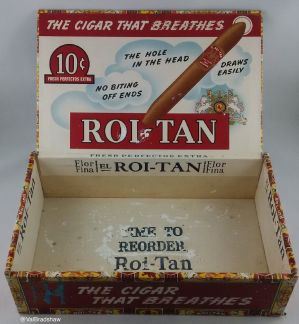#Cigar Boxes are fascinating.
I recently acquired several cases of some pretty interesting Cigar Boxes, from the days when you could still get a good 10 cent Cigar.
Let’s take a look at this vintage box from El Roi-Tan.

Top of the El Roi-Tan Cigar Box states the sticks are Mild Cigars.
Blue Stamp: Series 123 Class E 50
Impressive Crest including not one, but 2 Unicorns!

Bottom of the El-Roi-Tan Cigar Box:
Factory No 1898, 12th DIST. Pa.
“The Cigars herein contained were manufactured to retail at more than eight cents each and not more than fifteen cents each and are so tax paid.”
… looks like selective taxes were added to bring the cost per stick up to $1.50 each!
What I really like about this box is the inside top & bottom.
These people knew how to market their product.
“The Cigar That Breathes” utilizing lettering that represents a slight gust of wind.
An “Easy Draw” is something every Cigar Aficionado hopes for from their stick.
“The Hole in the Head” is classic!
“No Biting off Ends” … who needs a cutter when you’ve got a Rio-Tan Cigar, right?
… and look at all those clouds of tasty #CigarSmoke!

There’s the stamped reminder at the bottom of the box:”Time to Re-Order Roi-Tan” … just in case the Tobacconist wasn’t sure if it was the right time or not.
 According to Arlene B. Hirschfelder, author of “Encyclopedia of Smoking & Tobacco“, in the 1990’s only a few companies sold most of the Cigars in North America.
According to Arlene B. Hirschfelder, author of “Encyclopedia of Smoking & Tobacco“, in the 1990’s only a few companies sold most of the Cigars in North America.
Five (5) companies controlled 95% of the market in the United States.
One of them was Consolidated Cigar, who at the time, owned Roi-Tan, as well as Antonio y Cleopatria, Backwoods, Dutch Masters, El Producto,
La Corona & Muriel.
Roi-Tan, popular in the 1930’s…
According to the History of Cigars, competition was strong in the 1930’s which led to radio show sponsorships, partnerships with sports stars & celebrities … and contests:
1931 Radio is a hot fad with the public. PHILLIES, WHITE OWL, ROBT. BURNS, FLOR DE MANUEL, CREMO, LA PALINA, DUTCH MASTERS, X-TEDDY, ROI-TAN, LUCKY STRIKE and other brands of cigars and cigarettes sponsor radio programs, mostly music and comedy-variety shows.
1931 CREMO cigars gives away a “car-a-day” in a successful ad campaign.
With assistance of singer Sophie Tucker, ROI-TAN will conduct a similar campaign in 1939.
Source: http://cigarhistory.info/Cigar_History/History_1916-1962.html
Roi-Tan… a decades-old Cigar Company by the 1960’s.
Fast-Forward to the ’60’s and Altadis, through their website, had this background on their history, including that of Roi-Tan Cigars …
Gulf & Western acquired Consolidated Cigar in 1968.
The company entered the premium, hand-made cigar business through the formation of the Cuban Cigar Brands division in the Canary Islands.
Pepe Garcia, a major Cuban manufacturer whose factory in Cuba was nationalized by the Castro regime headed the division and expanded it by acquiring Moro Cigar Co. and its Primo Del Rey trademark.
In 1983, Golf & Western sold Consolidated Cigar Corporation to five of its senior managers.
Sixteen months later, the company was purchased by MacAndrews and Forbes, the holding company controlled by Ronald Perelman.
Mr. Perelman installed Theo Folz as President and CEO in August, 1984.
Theo was “born” in the cigar business, and under his leadership a new structure and culture began to emerge. Corporate politics were replaced by an emphasis on product quality and humanism.
In 1986, he acquired the assets of the American Cigar Company, which included the Antonio y Cleopatra, La Corona and Roi Tan cigar brands.
Early in 1993, the company was repurchased by MAFCO Holdings Inc., Ronald Perelman’s personal holding company. Because of the previous positive relationship between the two companies, management transition was smooth, and there were no changes in personnel, responsibilities or company direction. In August, 1996, Consolidated Cigar Corporation began selling shares to the public.
Then, in January, 1999, the company entered a new and exciting phase: Consolidated Cigar was purchased by Societe Nationale D’Exploitation Industrielle des Tabacs and Allumettes – SEITA, the former French tobacco monopoly. The merger of SEITA and Consolidated resulted in the world’s largest cigar company and positioned Consolidated Cigar to be a truly global company in the 21st Century.
In December 1999, Consolidated Cigar Corporation / SEITA entered into an agreement with Spanish tobacco giant Tabacalera S.A.
This new tobacco company was named ALTADIS, S.A. ALTADIS stands for Alliance Tobacco Distribution.
As a result of this merger, Hav-A-Tampa was brought into the fold and new facilities were added.
The new enterprise became the world’s largest cigar company with over 7,000 employees worldwide.
In September 2000, the parent company purchased 50% of Habanos S.A., owner of most of the Cuban trademarks in the world and franchiser of the Casa del Habano shops.
The final merger, resulting in today’s company, was completed in early 2008 when Altadis S.A. merged with Imperial Tobacco, headquartered in the UK.
Today, Altadis U.S.A. operates production facilities in the Dominican Republic, Honduras, Puerto Rico, Pennsylvania, Virginia and Florida.
The company also has production affiliations in Mexico, Brazil and Holland.
What an interesting history for Roi-Tan Cigars!
That’s your Cigar Box story for today.
